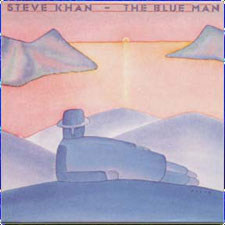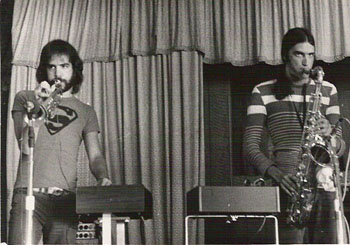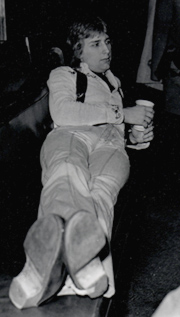

|
Soundclip:
|
| See Steve's Hand-Written Lead
Sheet |
|
Steve
Khan's
lead
sheet :  I guess the reason that "Some Down Time" is being offered dead last is because it was, without question, my least favorite tune from the recording! Recently, while doing some work for the website, I decided to give the piece another listen, and realized that there were certainly some redeeming qualties to it. Chief amongst them was the artistry and precision of the other musicians, they each performed spectacularly on it, and I will endeavor to single them out for recognition here. I guess the reason that "Some Down Time" is being offered dead last is because it was, without question, my least favorite tune from the recording! Recently, while doing some work for the website, I decided to give the piece another listen, and realized that there were certainly some redeeming qualties to it. Chief amongst them was the artistry and precision of the other musicians, they each performed spectacularly on it, and I will endeavor to single them out for recognition here.The basic 'groove' at [I] begins with Will Lee's thumbed or slapped bass, and Steve Gadd's 16th-notes on the hi-hat. The rhythm of this groove is certainly not original by any means, but I'm not at all certain as to just what might have influenced it. On the mini-score, you will see the written Fender Rhodes hits on beat 4 of bars 1 and 3. As an overdub, I doubled those voicings, played an octave higher, and using an MXR Flanger with the regeneration knob turned all the way up!!! Sometime later, when I recorded "Peg" with Steely Dan, I ended-up, because I had run out of imagination, using this same effect on the Intro to that tune. It's ironic because "THE BLUE MAN" was one of Donald and Walter's favorite recordings too. Go figure! The horn melody, which appears at [A] presented an interesting problem for me because I knew that I was going to have the three horns of the Brecker Bros. and David Sanborn playing the parts, but, there were only two notes for most of it. What do I do with the extra voice? Well, the solution was rather simple, but I learned a great deal from it all. I decided to have Sanborn's alto sax play the top voice, Michael's tenor would play the lower voice, and, when the 3rd voice appears, Randy would play the middle voice. It worked out great and, of course, their blend and their phrasing was impeccable. As we always did in those days, the horns were double-tracked and then, when mixed, one group was placed on the left side, and the other on the right. That's what contributes to giving this powerhouse mini-horn section its sound and feel.  Though I might have written about this in a prior presentation, it probably wouldn't hurt to share it again. I am speaking of writing and arranging for a small horn section such as this. Let's say 3-4 horns and in virtually any combination. Where four horns are concerned it could be: 2 trumpets, 1 tenor sax, 1 trombone; 1 trumpet, 1 alto sax, 1 tenor sax, 1 trombone; or just 2 trumpets and 2 trombones. Though I am hardly an accomplished expert at writing for horns, along the way, I have picked-up a couple of very useful tips from 'real' arrangers. The most useful one came from the great Don Costa, who was one of the most in-demand arrangers of his time, and for Frank Sinatra and everyone on down the line! When he was a player, he was a guitarist. And once, when we were briefly seated together in a moment of quiet, after I had complimented him and questioned him about his voicings for horns, he said to me, "You know, it is not so difficult, you have the tool right in your hands! In general, the way the guitar is laid-out gives you perfect spacing for virtually any 4-note voicing on the instrument." He went to share with me that, it is when guys try to get too fancy with pianistic clusters, etc. that the sonorities suffer. Obviously, some arrangers, Gil Evans, Oliver Nelson, and Clare Fischer come to mind, are more successful with their experimentations. So, I have always taken this sage advice to heart and I know that if it sounds good on the guitar, it will probably sound good when voiced for 3-4 horns. So, every horn voicing you see in letters [A] and [C] came directly from the guitar. But when you just add to that the spectacular instincts of Randy, Michael, and David things take on a level hithertofore unimagined. It is their very subtle usage of internal dynamics, dynamics within short spaces, their vibratos, and, of course, their sense of time!!! These elements, all or in combination, have influenced all those who have followed them, and this is a global influence, not just within the borders of the U.S. of floggin' A.! Now we arrive at the section, letter [B], which causes me the most anguish and grief. I hate the way I phrased the melody. And, I hate the fact that we are basically using a "'70s Disco" bass and drum groove! Those two things are just too much for me. While I was re-writing the lead sheet/mini-score, I transcribed a bit of what Will Lee improvised, and it was a lot of fun to see his imagination, and sense of 'swing' at play here.  With the arrival of [C] a different form of great artistry arrives. It begins with the incredibly precise and funky playing of Jeff Mironov on guitar, along with the rock-steady Rhodes of Don Grolnick. I wrote out the guitar part for Jeff, and the trick is that all the 'D's are played with your open 'D'-string. They could not have played this any better!!! At [C2], my guitar enters with a melody which I played using an old "Touch Wah" device which was known as the "Funk Machine." The three horns answer these phrases. This enter section does stand as a great example of Jazz-Fusion Horn Band Funk!!! The precision and funkiness from: Will, Don, Steve, Jeff, Mike, Randy, and Sanborn is way too much!!! Bravo guys!!! With the arrival of [C] a different form of great artistry arrives. It begins with the incredibly precise and funky playing of Jeff Mironov on guitar, along with the rock-steady Rhodes of Don Grolnick. I wrote out the guitar part for Jeff, and the trick is that all the 'D's are played with your open 'D'-string. They could not have played this any better!!! At [C2], my guitar enters with a melody which I played using an old "Touch Wah" device which was known as the "Funk Machine." The three horns answer these phrases. This enter section does stand as a great example of Jazz-Fusion Horn Band Funk!!! The precision and funkiness from: Will, Don, Steve, Jeff, Mike, Randy, and Sanborn is way too much!!! Bravo guys!!!We then return to a reprise of our principal melody at [A2], except this time, the section ends with a strong unison figure in bars 7-8. On my original charts, it was all written in 4/4, but obviously, when we were rehearsing it and working things out, we need to add an extra 2/4 bar to make for a more natural sounding drum break into [D] and the guitar solo section. Here, as an arranger, I employed a pretty common device, in the world of one-chord solo section, by having us modulate down a m3rd to Dm7. I had written out the Rhodes groove for Don and he played it great, as he always did everything! Once again, I have transcribed an excerpt of what Will Lee played, as he chose to ignore what I had written!!! He's no dummy!!! After the solo, we take the D.S. back to the dreaded [B] section, and reprise both [C] and [A2], before finally taking the Coda. With that, we arrive at [E] which is, in essence, a Fade on the [C2] groove. And what about this title? Well, because of Randy Brecker's classic, "Some Skunk Funk", I thought that I would always have one tune with the word "some" in the title on each recording. So, on "TIGHTROPE" we had "Some Punk Funk" and here, we were going to have "Some Down Time." Of course "down time" refers to the technical recording studio expression when some piece of Mesozoic equipment breaks down. Then, all the musicians yell out: "Down time!" because we know that we shouldn't be charged for the time we're sitting around waiting! Especially during the ancient times of recording there was always some down time each session! One could count on that!!!
After we had recorded the track, I received a phone call from Kim Ferguson, Maynard's daughter and, at that time, his business manager as well. During that call, she said to me: "Steve, I understand that we've recorded a tune of yours. What are you doing with the publishing?" To which I responded: "Nothing, I always handle my own publishing!" She then proceeded to say: "Well Steve, you know we usually get the publishing when we record outside material." To that, I responded by saying: "Well, I can't believe that you are receiving pieces of the publishing of tunes by Bob James or Eric Gale?" Kim continued, "You know Steve, Maynard's last recording went 'gold' so, as the writer, you are pretty much guaranteed to make quite a bit of money!" I then said, "So, basically what you're saying is that, for me, 50% of something is far better than 100% of nothing! Right?" I then explained what had happened to me some years before, during David Sanborn's "TAKING OFF" recording, where I had been intimidated and taken advantage of by the producer, and I gave-up the publishing to the first two tunes I ever had recorded. It was one of the biggest business mistakes of my life. You see, at that time, I was under the most naive impression that, in order to have one's own publishing company, it would require me to get an office on Madison Ave. with 5 secretaries, etc.!!! How very wrong I was! Both Randy Brecker and Don Grolnick begged me not to sign over any portion of my publishing, but I was young and naive, and I allowed myself to be intimidated! I did not realize then that one can actually do everything from their home. In those days, all you needed was a typewriter, now one can do it all with a computer and the Internet!!! It is all so easy. Anyway, I closed by saying to Kim: "You know, who is to say that it won't be MY TUNE that actually helps Maynard sell more records? Can you say for certain that THIS won't be the case? Of course not!" For better or worse, the tune was never completed, and obviously did not appear on the LP. I have never felt bad about this. I only harbor bad feelings about having been bullied about the publishing for this tune. Sadly, this is a most common practice in the music business. And, for all you younger players and writers reading this, protect yourself and your work, and never fall for such nonsense. Especially in the "Jazz" business!!! This story from the past was written long before the recent passing of Maynard Ferguson, just this August, of '06. It is most unfortunate, but, in the end, the truth of this particular episode remains unchanged. And, if it serves to help someone from making a terrible error, then I am really glad. By the way, after nearly 25 years of non-payment of royalties, after finally being prepared to actually go to court and sue this most dishonest and unscrupulous producer, both copyrights to "Mr. Butterfat" and "Duck Ankles" were returned to me. It really becomes an issue of principle and integrity, and I will rest much easier knowing that my son or his future children, should a music business miracle ever occur, would be the beneficiary of any future recordings of those tunes. It should have always been that way.
[Photo of Will Lee by: Chuck Stewart from 1976
Photo of Randy and Michael Brecker with Dreams from 1972 Courtesy of Peter Erskine] |